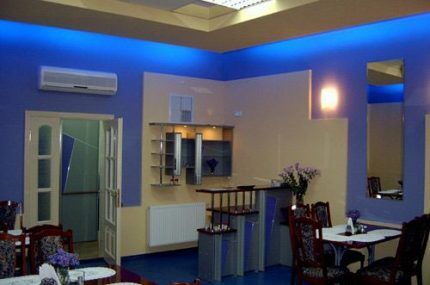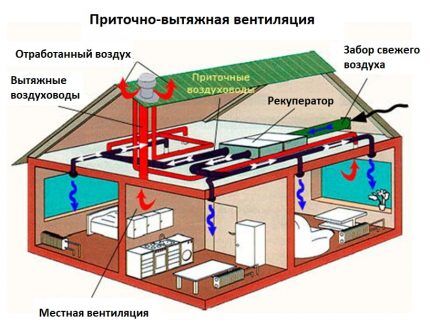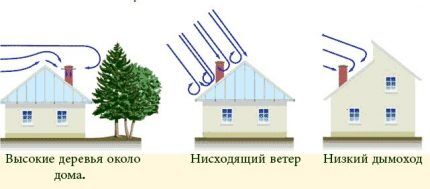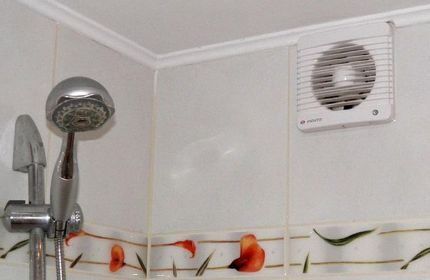Ventilation in a private house: supply and exhaust systems + tips for arrangement
Due to poorly organized air exchange, the microclimate in the cottage often becomes unfavorable and uncomfortable. As a result, the health of the people living in it deteriorates, and the decoration and furniture suffer from excessive humidity or excessive dry air. And only properly organized ventilation in a private home can prevent these problems.
How to properly equip it and what type of system to choose? We will consider these questions in our article. We will also look at choosing the optimal ventilation scheme for the cottage and ensuring a sufficient level of air exchange in individual rooms of the house.
The content of the article:
Classification and types of ventilation systems
The creation of ventilation in the cottage is due to the fact that there must be a continuous exchange of air masses in it. Old, used air with a large amount of carbon dioxide must be removed from the premises, replacing it with new air that constantly contains oxygen - from the street.
If you stop this air exchange, the microclimate inside will quickly become far from favorable for human health.

In order to maintain the air exchange parameters established by GOSTs, the ventilation system in the house, made with your own hands or with the involvement of third-party installers, must continuously change the air in the rooms.
For example, for living rooms in a cottage, the air exchange rate per hour is set to “1”. That is, within an hour the entire volume of air in them must be completely replaced.
The purpose of ventilation is to combat the following factors:
- excess heat;
- constantly appearing dust;
- excessive air humidity;
- harmful gases and vapors.
Every person in the house exhales carbon dioxide around the clock. Also in the residential building there are fireplaces, gas and electric stoves, numerous household appliances, that is, there are a lot of sources of heat, moisture, dust and gases in the cottage. And all this must be removed from the premises so that the microclimate in them is suitable for living.
According to the method of air movement, ventilation systems are divided into:
- With natural cravings.
- With mechanical urge.
First option involves the movement of air masses due to the existence of a pressure difference outside and inside the ventilated building. Moreover, it can be organized - using adjustable valves, and unorganized - exclusively through windows, doors and vents in the foundation.
In the second case air is forced to move through rooms and ventilation ducts using mechanical devices. This option is energy dependent, but more effective.

According to their purpose, ventilation systems are divided into:
- inlet;
- exhaust;
- combined.
The former work to supply air into the home from the outside, and the latter to extract air from the building. The third option - supply and exhaust structures are a symbiosis of the first two. We discussed in detail the features of calculating the supply and exhaust system in this article.
Principles of ventilation
Previously, housing was built with wooden windows and doors. Moreover, they did not shine with special tightness. As a result, through the existing cracks there was a constant and natural exchange of dirty indoor and clean outdoor air.
However, now they have been replaced by plastic window and door blocks, which are an order of magnitude more airtight. Therefore, as an option, they install a special device on such windows - supply ventilation valve.

The operating principle of the home ventilation system is based on the continuous influx of new air masses from the street. As a result, they gradually replace the existing air in the rooms, squeezing the old air out. This removes carbon dioxide, odors and moisture from the house.
The points of influx of new air are:
- window;
- doors;
- vents in the foundation and basement;
- window air conditioners.
We talked about fresh air ventilation in detail in next material.
Used air is removed from the premises through windows and doors during ventilation, as well as a ventilation pipe (shaft) or exhaust valve.
Option #1 - natural draft system
A non-mechanical ventilation system works due to the formation of natural draft in a vertical pipe.
This is the principle of operation of a classic wood stove or fireplace chimney. In both cases, pressure is created below, pushing the air upward and outward.

The traction force is also affected by the moisture saturation of the air. The drier it is, the heavier it is. Moist air masses inevitably tend to rise to the ceiling and then into the ventilation duct if it goes outside the building.
The main disadvantage of natural ventilation lies in its poor controllability. With strong winds, formation is possible reverse thrust. In winter, due to the temperature difference, the system works very efficiently, in some situations even to excess, drawing precious heat out of the house.
And in summer its effectiveness drops significantly. Temperatures in the rooms of the cottage and outside in the summer do not differ much, so the draft inevitably decreases.

To control the quality of air exchange in such a system, the ventilation ducts in it must be equipped with check valves. If necessary, you can cover them to reduce natural traction.
Option #2 - forced incentive system
If the natural ventilation system is not capable of maintaining the proper microclimate in the cottage, then it has to be replaced with supply or exhaust mechanical ventilation.
In this case, air flows are forced to move through the interior spaces using fans.
A combined variation of the system is also possible - with supply and exhaust circuit. In it, the volumes of both supply and exhaust are controlled by ventilation units.

In some situations, such a system additionally puts recuperator, which takes heat from the air from the rooms and then gives it to the street.
Exhaust fans are installed in each room or one per ventilation shaft. And air supply units in private homes are usually equipped in the form of wall-mounted vents with an axial electric fan inside.
But an option is also possible with a single air blower and ventilation ducts throughout the building.
If supply and exhaust ventilation is done, then it requires laying two separate ventilation ducts - one goes to the exhaust, the second to the supply.
This seriously affects the cost of the system, but allows it to be more precisely regulated and controlled.
Which scheme is better for a cottage?
To decide which and how best to install ventilation in a private home, you need to take into account a lot of factors. The characteristics of all engineering systems and heating devices in the building are important here.
When choosing the appropriate type of ventilation system, you should consider:
- climatic features of the area;
- the presence of sources of unpleasant and harmful impurities in the air near the house;
- purpose of different rooms;
- individual features of the building's architecture;
- the presence of gas stoves or boilers, as well as fireplaces or wood/coal stoves;
- the number of permanent residents in the cottage and much more.
It is recommended to design and install only natural ventilation yourself. To calculate it, simplified methods with averaged indicators are used. Understanding them is not difficult.
For living rooms, the air exchange rate is set at 30 m3/hour, for bathrooms and toilets within 25–30 m3/hour, and for the kitchen – 70–100 m3/hour. Based on this data and the cubic capacity of the rooms, you only need to calculate the width of the ventilation ducts, and then arrange them in the building.
Moreover, it is best to do this at the cottage design stage. Often the best option is a ventilation shaft in the middle of the building with its outlet above the roof ridge.

If a private house is being built on two or three floors and a forced air exchange system is chosen for it, then it is better to entrust its design to a professional. You can then do the installation yourself.
However, if you have no experience in this matter and do not want to encounter problems in the future, then the installation of all ventilation equipment should also be entrusted to a specialist.
Compared to mechanical ventilation, natural ventilation is cheaper, less noisy and does not depend on the availability of power. However, it is more difficult to regulate. Plus, its thrust is highly dependent on external atmospheric factors.
But the absence of electric fans means no problems with breakdowns and no need for their maintenance.
A forced ventilation system in a private house in a combined or only exhaust or supply version is more complex to install and operate. However, it allows you to save on heating and more accurately control the microclimate in the cottage.
Recommendations for individual rooms
When installing any ventilation in a private home, air flows are arranged in such a way that clean street air first flows into the living room, bedrooms, study and library.
And then along the corridors he must go to the kitchen, bathroom and pantry with access to the exhaust ventilation shaft.


In the kitchen, in addition to the ventilation hole, it is recommended to additionally install hood over the stove. It will allow you to quickly remove cooking odors, preventing them from spreading to other rooms in the house.
A separate point is the boiler room and kitchen with gas equipment. They must be equipped with a separate channel for air flow directly from the street. Plus don't forget about chimney.
This will ensure that oxygen for combustion enters the firebox in the required volume, and carbon monoxide will immediately leave the room.
Conclusions and useful video on the topic
From the following video you can learn how to correctly draw up a supply ventilation project:
How to implement fresh air ventilation in a cottage with your own hands:
Operating principle of the indoor ventilation system:
The easiest and cheapest way to do classic natural ventilation in a private house.
But if the cottage is large in size, with many residential and non-residential rooms, a fireplace and gas-powered equipment, then you will need to equip its mechanical equivalent. This system will be more expensive to install and operate, but the air exchange and microclimate inside will be at the proper level.
Are you comparing ventilation systems for a private home and can’t decide on the best option in your case? Ask your question to our experts in the comments to this article.
Or maybe you still have questions about the nuances of arranging a ventilation system and the rules for choosing equipment? Ask for advice in the comments block - we and experienced visitors to our site will try to help you.




I have decided to build a small cottage in the village by summer so that I can relax with my family in the fresh air more often. I somehow didn’t even think about ventilation. But the cottage will be small, maybe just some ventilation will be enough? Or will ventilators have to be installed in any case: with or without ventilation? And it’s also interesting, do the ventilators need to be controlled or do they already have a program for optimal air flow into the room?
Good day, Andrey. You probably mean micro-ventilation on the windows. They work on the principle of opening the sash by 6 mm. This is to retain heat in the cold season, but in the warm season the window simply opens to the “hinged” position.
No, micro-ventilation alone is not enough. It is necessary to provide adequate ventilation in at least two rooms: the kitchen and the bathroom.
Understand that ventilation works on the principle of air inflow/outflow. An open window is an inflow, but an outflow? This can only happen if the windows on opposite sides of the cottage are opened. Objectively, this is not a way out.
Alexey, hello! I bought a town from a developer with an open plan and made my own design project, which I brought to life. On the ground floor of the town, a wall-mounted boiler with a coaxial chimney was installed (by the developer according to his gas project). The project also specifies 4 ventilation pipes, each 125mm, specifically for ventilation (floor area is approximately 40 sq m). During the renovation process, I used these 4 pipes as: for the background (sewage), for the kitchen, for 2 bathrooms. As a result, I don’t have 4 free ventilation ducts just for them! Gas workers do not turn on the gas due to the absence of these 4 pipes. What, in your opinion, can be done in the finished renovation to ensure ventilation on the 1st floor, where that same boiler hangs?